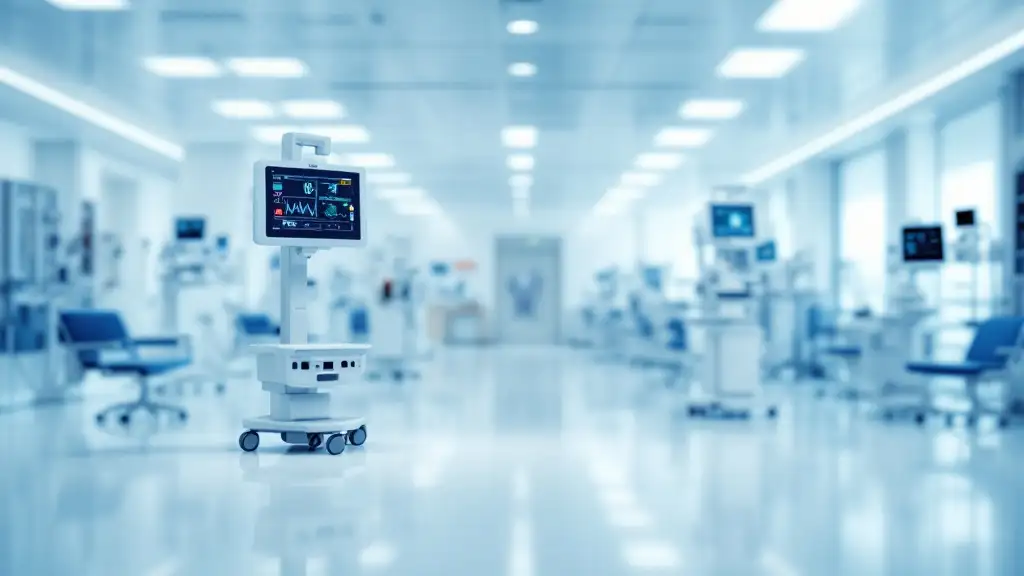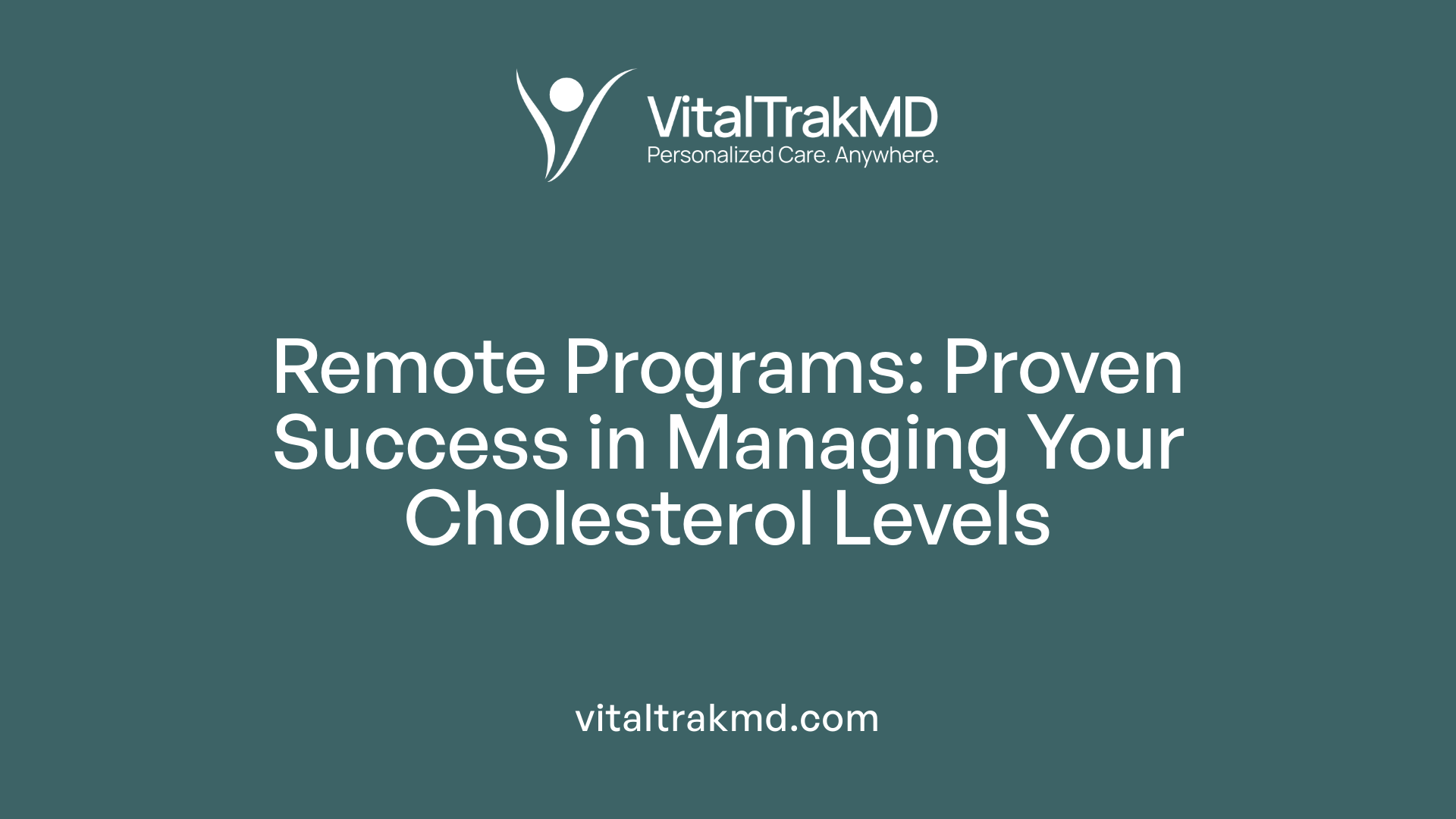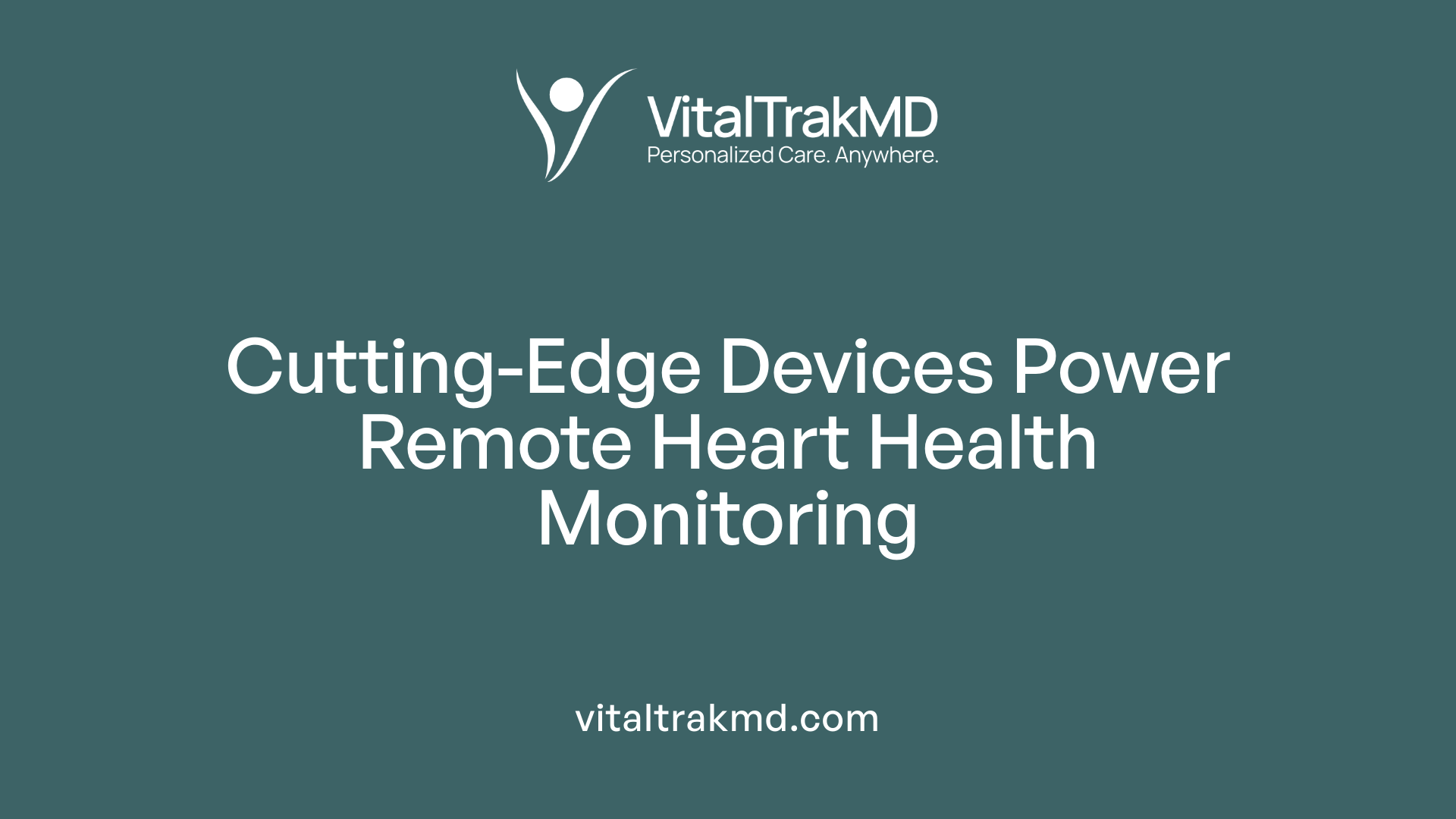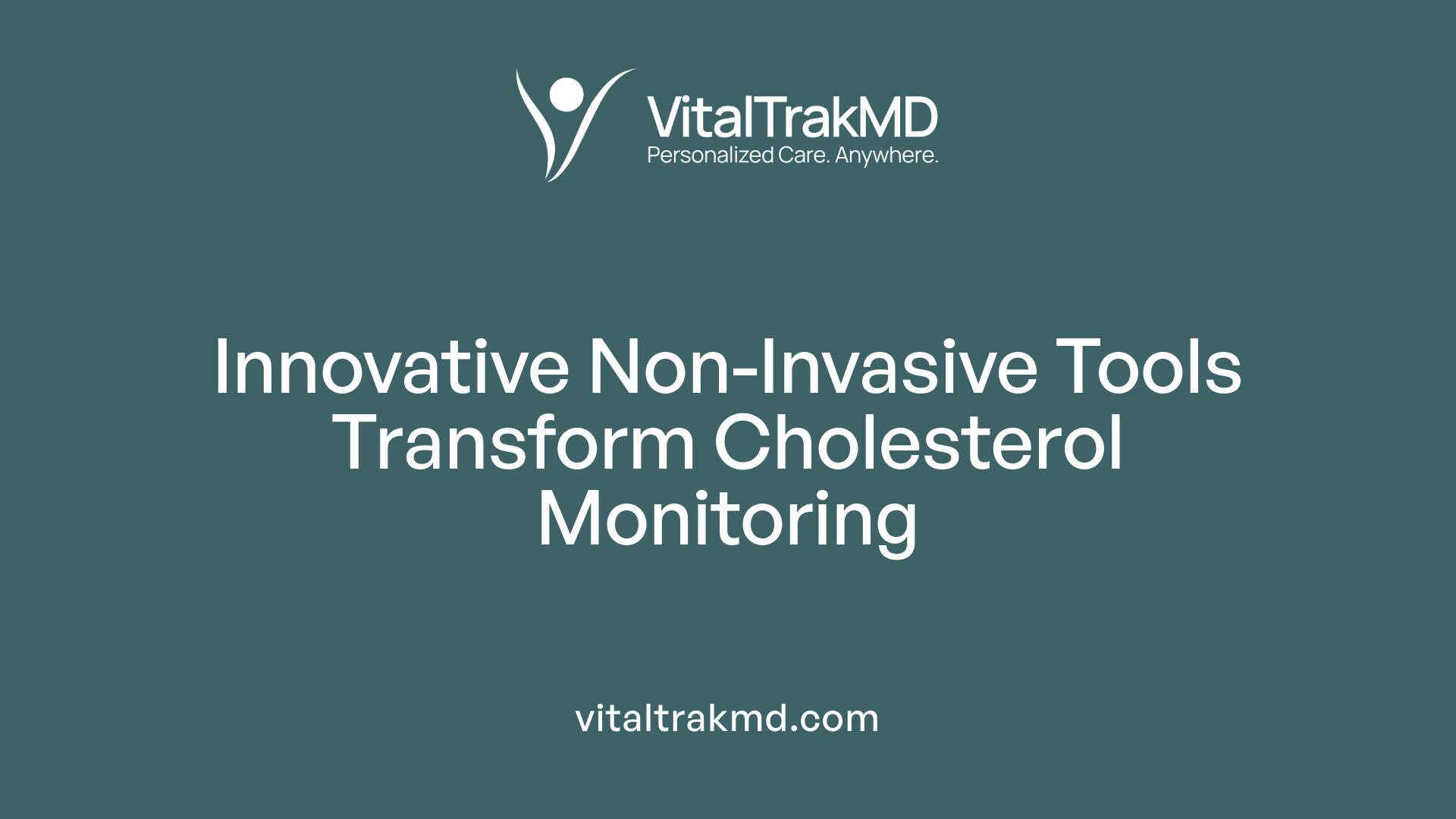Managing High Cholesterol Through Remote Tracking

Transforming High Cholesterol Management Through Technology
Advances in remote health monitoring have opened new pathways for managing high cholesterol and blood pressure. These innovative approaches leverage digital tools, wearable devices, and multidisciplinary remote programs to enhance patient care, improve health outcomes, and increase access to guideline-directed therapies across diverse populations.
The Impact of Remote Monitoring on Managing High Cholesterol and Blood Pressure
How can remote patient monitoring help manage high cholesterol and blood pressure?
Remote patient monitoring (RPM) has transformed the way healthcare providers manage chronic conditions like high cholesterol and hypertension. This technology uses connected devices such as Bluetooth-enabled blood pressure cuffs and digital lab reporting tools to transmit vital sign data directly to healthcare teams in real time.
When patients use these devices at home, their blood pressure and cholesterol levels are continuously tracked and shared with providers. This immediate access allows healthcare professionals, including pharmacists and patient navigators, to review data regularly and make swift medication adjustments based on clinical algorithms. This proactive approach helps in fine-tuning treatment plans without needing frequent office visits.
Studies involving over 10,000 diverse participants have demonstrated that remote monitoring significantly lowers systolic and diastolic blood pressure. For example, participants experienced an average reduction of around 9-10 mm Hg systolic and 5 mm Hg diastolic after 12 months of program engagement. Similarly, LDL cholesterol levels decreased by approximately 35-38 mg/dL, reaching guideline-recommended targets in many cases.
These reductions are not only clinically meaningful—they can substantially decrease the risks of serious cardiovascular events such as strokes and heart attacks. Importantly, the programs are designed to be inclusive, offering translated educational materials and eliminating the need for smartphones or Wi-Fi to barriers for underserved populations. Such broad accessibility ensures that diverse groups can benefit from remote management.
In summary, remote patient monitoring enhances the management of high cholesterol and blood pressure by enabling continuous, real-time data collection, facilitating prompt medication adjustments, and supporting lifestyle changes. The scalable nature of these programs means that more patients can achieve health goals, ultimately leading to improved cardiovascular health outcomes across populations.
Effectiveness of Remote Healthcare Programs in Cholesterol Control

How effective are remote healthcare programs in controlling cholesterol levels?
Remote healthcare programs have demonstrated substantial success in managing cholesterol levels across diverse populations. By leveraging digital health tools such as connected home cholesterol monitors and algorithm-guided medication titration, these programs enable continuous, real-time monitoring and personalized treatment adjustments.
Participants in these programs have experienced impressive LDL-C reductions. On average, LDL cholesterol levels dropped by approximately 37.5 mg/dL at the 12-month mark, with early results at six months showing reductions around 35 mg/dL. These decreases are significant in reducing the risk of cardiovascular disease and help patients reach guideline-recommended LDL-C targets.
The programs are designed to promote medication adherence and encourage lifestyle changes, which are crucial for long-term cholesterol management. With active engagement of multidisciplinary teams—including pharmacists and patient navigators—remote interventions also improve access to guideline-recommended therapies, especially among underserved and diverse populations.
Outcomes have been consistent across racial, ethnic, and language groups, emphasizing the inclusive nature of these digital health approaches. Moreover, the integration of educational resources, interactive digital tools, and real-time feedback has reinforced positive habits and sustained cholesterol control.
In summary, remote healthcare programs have proven to be highly effective in lowering LDL-C levels, achieving high rates of guideline goal attainment, and potentially decreasing the risk of future cardiovascular events.
LDL-C Reduction Statistics
| Time Period | Average LDL Reduction | Percent Decrease | Additional Details |
|---|---|---|---|
| 6 months | 35.4 mg/dL | About 25% | Compared to baseline |
| 12 months | 37.5 mg/dL | About 27% | In participants with active medication management |
| Overall | 50% reduction from baseline (average LDL levels from 140 mg/dL to 70 mg/dL) | Among patients reaching LDL-C goals |
Medication Management Success Rates
Regular medication titration is vital for optimal cholesterol control. Nearly 23% of patients in lipid programs and 15% in hypertension programs had their medications up-titrated within three months, indicating active management. Overall, more than 80% of participants achieved LDL-C goals, reflecting high success rates in therapy optimization.
Population Health Benefits
Implementing remote systems at a large scale, involving over 10,000 patients, has shown that it's possible to improve cholesterol and blood pressure outcomes across entire healthcare networks. The inclusive approach—translating materials into multiple languages and removing barriers like smartphone or Wi-Fi requirements—ensures broader access.
This can lead to decreased cardiovascular events, reduced hospitalizations, and enhanced health equity. The scalability supports public health efforts to manage chronic diseases more efficiently.
Long-Term Health Outcomes
Sustained LDL-C reduction and blood pressure control are both associated with lower incidence of heart attacks, strokes, and other cardiovascular complications. The continuous monitoring and medication adjustment available through these programs promote adherence and long-term health.
Future enhancements, including wearable and smartphone integration, are poised to further improve prediction and management, leading to better long-term health outcomes.
| Aspect | Impact | Supporting Data | Notes |
|---|---|---|---|
| LDL-C reduction | Significant decrease in cholesterol levels | 37.5 mg/dL at 12 months; 50% from baseline | Achieves guideline targets |
| Blood pressure control | Reduced systolic and diastolic BP | -9.7 mmHg systolic, -5.2 mmHg diastolic at 12 months | Increases cardiovascular safety |
| Therapy adherence | Improved medication compliance | 80%+ reaching LDL goals | Enhanced by digital support |
| Population reach | Broader, equitable access | Translated materials, no smartphone/Wi-Fi needed | Addresses health disparities |
| Long-term health gains | Reduced cardiovascular events | Lower hospitalization and complication rates | Promising for future public health strategies |
In conclusion, remote healthcare programs play a vital role in modern cholesterol management by offering personalized, accessible, and effective treatment options that can lead to healthier populations and lower cardiovascular risks.
Technologies Driving Remote Lipid and Blood Pressure Monitoring

What technologies are used for remote tracking and digital health interventions for hyperlipidemia management?
Remote management of high cholesterol and blood pressure heavily relies on innovative digital health tools. Connected home testing devices play a central role, allowing patients to measure their lipid levels and blood pressure conveniently from home. These devices, such as digital cholesterol monitors and Bluetooth-enabled blood pressure cuffs, can transmit data directly to healthcare providers in real time.
Wearable health sensors complement these devices by continuously tracking physical activity, heart rate, and other vital signs. This real-time data provides a comprehensive view of a patient's cardiovascular health outside the clinical setting.
Digital health platforms—such as mobile health apps and telehealth portals—are integral in supporting ongoing patient engagement. They enable medication titration, provide educational content, and facilitate direct communication between patients and healthcare teams. These platforms often include tools for tracking medication adherence, dietary habits, and lifestyle changes.
Automated workflows further streamline care. These are established via software that supports guideline-based medication adjustments, medication reminders, and alerts for abnormal readings. Pharmacists and clinicians utilize these automated systems to remotely titrate medications, ensuring treatments remain aligned with best practices without requiring frequent in-person visits.
The integration of remote monitoring data with electronic health records (EHRs) and analytics platforms enhances personalized care. It allows healthcare providers to detect early signs of lipid abnormalities, monitor adherence to therapy, and modify treatment plans promptly.
Together, these digital tools and systems significantly improve patient engagement, treatment outcomes, and broad access to cardiovascular health management. They are especially crucial in serving underserved populations, eliminating barriers associated with traditional healthcare delivery.
| Technologies | Description | Impact |
|---|---|---|
| Connected home testing devices | Bluetooth-enabled lipid and blood pressure monitors | Facilitate real-time data transmission and remote assessments |
| Wearable health sensors | Track activity, HR, and vital signs continuously | Support ongoing health monitoring beyond clinical visits |
| Digital health platforms | Mobile apps, telehealth portals | Enhance patient education, medication management, and communication |
| Automated workflows | Software-supported medication titration and alerts | Support guideline-aligned treatment adjustments remotely |
This collection of digital health tools is transforming how chronic diseases like hyperlipidemia are managed, making care more accessible, personalized, and effective.
Emerging Non-Invasive Methods and Wearable Technologies in Cholesterol Monitoring

Are there non-invasive methods for remote monitoring of cholesterol levels?
Yes, significant advancements are being made in non-invasive monitoring technologies for cholesterol. Researchers and companies are developing innovative methods that aim to reduce or eliminate the need for traditional blood tests.
One promising development involves smart contact lenses that contain electrochemical biosensors. These lenses can detect cholesterol present in tear fluids, providing real-time, wireless measurements. Users can often see their results on connected smartphones, making it convenient for routine monitoring.
In addition to contact lenses, wearable hydrogel-based devices are emerging as another solution. These patches attach to the skin and use electrochemical reactions to analyze biomarkers like cholesterol and lactate. They transmit data wirelessly to smartphones or healthcare providers, enabling continuous tracking without invasive procedures.
Breath analysis also offers a non-invasive pathway. Specialized gas sensors, combined with machine learning algorithms, analyze exhaled breath to estimate total cholesterol levels. This approach is still in experimental stages but shows great potential for quick, easy testing.
Another notable technology involves microneedle systems. These tiny needles penetrate the outer skin layer to extract interstitial fluid, which contains biomarkers similar to blood serum cholesterol. This minimally invasive method can provide accurate cholesterol readings with less discomfort than traditional blood draws.
These innovations aim to simplify cholesterol management, particularly for individuals needing frequent testing or those who are hesitant about blood sampling. They are part of a broader push toward digital health solutions that make cardiovascular monitoring more accessible.
Potential benefits include:
- Greater convenience and comfort for patients
- Increased adherence to monitoring routines
- Real-time data that supports prompt medical decisions
- Reduction in clinic visits and associated costs
As technology continues to advance, these non-invasive methods are expected to become more accurate and widely available. They hold the promise of transforming how we monitor and manage cholesterol, making the process easier and more integrated into daily life.
| Technology Type | Description | Key Advantage | Status |
|---|---|---|---|
| Smart contact lenses | Embedded biosensors measuring tear cholesterol | Real-time, wireless, non-invasive | Developing |
| Skin patches (hydrogel devices) | Electrochemical sensors on skin surface | Continuous, comfortable monitoring | Emerging |
| Breath analysis | Gas sensors and ML algorithms | Quick, non-invasive estimation | Experimental |
| Microneedle systems | Tiny needles for interstitial fluid extraction | Accurate, minimally invasive | In development |
These advancements are supported by ongoing research and increasingly sophisticated digital health platforms. They are expected to further improve health outcomes by enabling early detection and better management of cholesterol-related cardiovascular risk.
For more information, search queries like "Non-Invasive Cholesterol Monitoring Technologies" highlight the rapid growth and clinical trials of these innovative solutions, promising a future where managing heart health is easier, less invasive, and more effective.
Integrating Digital Platforms and Educational Resources for Effective Cholesterol Management
What educational resources and strategies are available for remote cholesterol management?
Remote cholesterol management relies on a variety of educational tools and approaches designed to empower patients and improve health outcomes. Patients have access to online guidelines, mobile applications, and telehealth consultations that provide valuable information about cholesterol, its risk factors, and lifestyle modifications.
Digital health apps often include features for self-monitoring, such as logging dietary intake, physical activity, and cholesterol levels. These apps can send alerts and reminders for medication adherence and routine check-ups, ensuring continuous engagement.
Clinician-led educational programs are tailored to reinforce understanding of lipid management, utilizing virtual platforms for seminars, Q&A sessions, and personalized counseling. Incorporating decision-support algorithms within electronic health records (EHRs) helps clinicians provide evidence-based advice and adjust treatment plans dynamically.
Motivational interviewing techniques conducted remotely foster positive behavioral changes and commitment to health goals. Virtual lipids clinics and pharmacist-driven telemedicine programs leverage digital tools—including home blood pressure and cholesterol testing devices—to facilitate medication titration and progression toward target levels.
A multidisciplinary team approach enhances patient support, involving physicians, pharmacists, nurses, and community health workers. This collective effort ensures patients receive continuous guidance on medication management, lifestyle adjustments, and goal setting, bridging gaps often encountered in traditional care settings.
Together, these educational resources and strategies aim to make cholesterol management more accessible, personalized, and effective outside the confines of in-person visits, thereby improving long-term adherence and cardiovascular risk reduction.
Harnessing Digital Innovation for Better Heart Health
The integration of remote monitoring technologies, digital health platforms, and educational resources is transforming how clinicians and patients manage high cholesterol. These strategies not only enhance personalized care and medication adherence but also address healthcare disparities by increasing access to effective therapies across diverse populations. As technology continues to evolve—with innovations like wearable sensors and non-invasive testing—remote cholesterol management is poised to become a cornerstone of preventive cardiovascular care, ultimately reducing the global burden of heart disease.
References
- Study Shows Remote Patient Monitoring Improves Blood ...
- A Remote Technology-Enabled, Algorithm-Guided ...
- Remote BP, cholesterol management program may ...
- Results of a Remotely Delivered Hypertension and Lipid ...
- Mass General Brigham Remote Healthcare Delivery ...
- Remote BP and LDL-C Monitoring Programs Promote ...
- Telehealth Interventions to Improve Chronic Disease
- How care providers support cholesterol management ... - Livi
- A Remote Technology-Enabled, Algorithm-Guided ...
- Results of a Remotely Delivered Hypertension and Lipid ...
Recent articles
Want to Feel Better and Live Healthier?
Join hundreds of patients taking control of their health with personalized care that fits their life – not the other way around.
Rated 4.8/5 by 32+ customers







